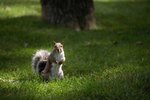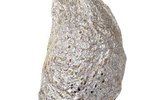
The word porcupine in Latin means "quill pig." It's an inaccurate scientific description as porcupines are rodents and pigs are even-toed ungulates. Yet Latin isn't the only language misidentifying the porcupine: The French word equivalent to the English porcupine is porc espin or "spined pig". In either case, the wording focused on the porcupine's quills accurately depicts the feature he is best known for having.
Sharp Quills
The more than 30,000 quills covering the body of a porcupine represent this critter's most obvious and most effective defense adaptation. These are stiff, hollow hairs made of keratin and approximately three inches in length with a sharp barb at the end. Each is encased in its own sheath protecting it until the porcupine senses a threat and releases the quill. The barb at the end is like a fish hook -- it embeds itself in the muscle of whatever attacked the porcupine. As the quill victim tries to free itself, the sharp barb only digs in further.
Underfur and Guard Hairs
These are two other adaptations of hair covering the porcupine's body. The underfur is a thick yet very fine dark-colored hair covering the skin. It serves as an insulator keeping the porcupine warm in the winter. The guard hairs are over the top of the underfur on the back and tail. They grow as long as four inches and serve as protection for the underfur.
Toes And Claws
The porcupine's front feet have four toes. The back have five toes. Each toe ends in a sharp, strong claw the porcupine uses for two purposes: The first is to help him gain access to his strictly vegetarian diet. He uses the claws to dig plants, tear tree bark and pull berries off the vine. The second use involves digging his strong claws in to trees to anchor himself as he climbs.
Teeth
Porcupines have four sharp incisor teeth in the front of their mouth. These are often compared to a chisel. Their teeth continue to grow throughout their lifetime. To prevent the teeth from curling over, porcupines trim their teeth by chewing on wood. Their teeth often take on an orange tint from the tannin enzyme in wood.
References
Resources
Photo Credits
-
Jupiterimages/liquidlibrary/Getty Images
Writer Bio
Amy M. Armstrong is a former community news journalist with more than 15 years of experience writing features and covering school districts. She has received more than 40 awards for excellence in journalism and photography. She holds a Bachelor of Arts in communications from Washington State University. Armstrong grew up on a dairy farm in western Washington and wrote agricultural news while in college.




